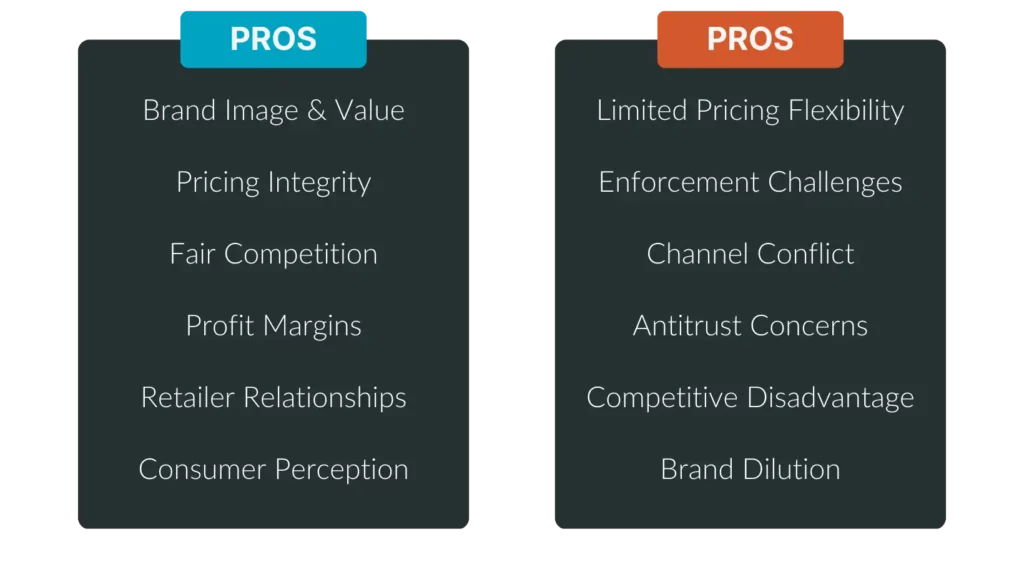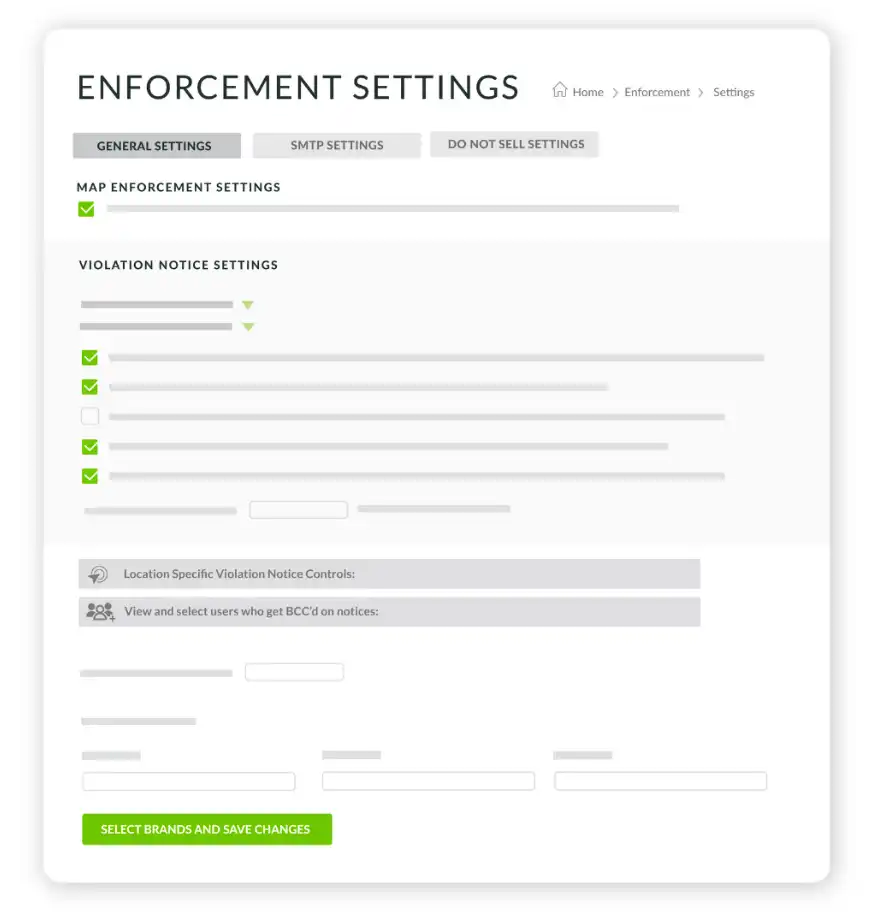Introduction
In the world of retail, stores that get the highest sales with the highest profit margins are the ones regarded as successful. To reach that achievement, an organization’s sales and marketing department must employ a variety of strategies to attract as many customers as they can while outperforming competitors. One often-used tactic is to set retail prices as low as possible.
While this is a win for consumers, such a business practice can encourage price wars and set a precedent for market monopolies, brand equity erosion, and product devaluation. To prevent these problems from happening and protect the interests of all parties, governments allow the setting of pricing policies under Fair Trade Laws. One of these policies is the MAP Pricing Policy. This article shares the foundations of MAP policies that you need to know as a brand owner or manufacturer.
What is a MAP Pricing Policy?
MAP, which stands for Minimum Advertised Price, refers to the lowest price at which a manufacturer allows its products to be advertised or publicly displayed. It is a guideline established by brands to maintain price parity and encourage fair competition across the different retailers that sell their products.
Retailers are typically prohibited from advertising goods below this minimum price, although they can sell the products at any price they choose. However, if a retailer breaches a MAP policy, the manufacturer or brand has the legal right under the Federal Trade Commission’s Antitrust Law to cease doing business with that trade partner.
It is the aim of a MAP policy to protect a brand’s image, maintain perceived product value, and create a fair competitive environment among retailers.
MAP Policy vs. MSRP
There is another guideline that is sometimes mistaken as MAP Policy Pricing, and that is the MSRP (Manufacturer’s Suggested Retail Price). MSRP serves as a recommendation by the manufacturer on how much their products should be sold. It’s a guidance to retailers about the brand’s suitable selling price for their goods, but unlike MAP, it doesn’t dictate the minimum advertised price or impose penalties for deviations.
In a nutshell, MSRP provides flexibility for retailers to adjust prices based on market conditions while MAP Policy pricing concentrates on outlining a minimum price for how products are promoted to ensure brand integrity and pricing consistency.
MAP vs. IMAP or eMAP
There is another type of MAP that focuses on regulating the advertising of product prices on the Internet. It is called the IMAP (Internet Minimum Advertised Price) or eMAP (Electronic Minimum Advertised Price). Simply speaking, IMAP specifically addresses online advertising, acknowledging the unique challenges and dynamics of e-commerce.
IMAP or eMAP extends the concept of MAP from all the known traditional advertising channels to the digital/online realm, ensuring that online retailers adhere to a minimum advertised price.
Why is MAP Policy Pricing Important for Brands?
Setting a Minimum Advertised Price is crucial for brands as it plays the pivotal role of maintaining a consistent and trustworthy image among consumers in the market they belong to. By establishing a MAP, manufacturers can control how their products are presented to consumers across the various retail channels.
This strategy helps avoid the aggressive pricing competition often seen in retail, which can lead to a decrease in the brand’s value and a reduced perception of product quality. The best example scenario for this is a customer choosing to buy a slightly pricier Bluetooth speaker from Store A because Store B made them think that the same speaker they were putting on display with a much cheaper price tag was fake. When in reality, both devices were produced and shipped out by the same manufacturer.
Setting a Minimum Advertised Price (MAP) is crucial for brands to maintain a perception of value and exclusivity in their products. It promotes fair competition among retailers by preventing a downward spiral in pricing, which can harm profit margins. This policy encourages retailers to differentiate themselves through aspects like customer service, product knowledge, and overall shopping experience, instead of relying solely on price competition. Apple Inc. is an example of a company that effectively leverages these benefits.
Ultimately, leveraging MAP Policies is a strategic tool for brands to safeguard their reputation, maintain pricing integrity, and create stable and sustainable retail environments for their products. Violations of MAP Policies can result in consequences that strengthen adherence to these guidelines, fostering a mutually beneficial relationship between manufacturers and retailers.
How is MAP Pricing Calculated?
It’s common for retailers to be curious about the criteria their business partners use to establish Minimum Advertised Prices (MAPs) Typically, brands make calculations based on various factors, such as production costs, desired profit margins, market conditions, and the recognized value of the product. Brands may also consider the competitive landscape and consumer demand when setting a MAP.
Here is a sample calculation/formula of a product’s Minimum Advertised Price:
Manufacturers usually create a MAP by reducing their own recent, current, or planned MSRP by 20%. For example, if a local bakery gave their top-selling Egg Bread an MSRP of $10, that would give us a MAP of $8 ($10 x 20% = $2; $10 – $2 = $8). Remember that this is only a generalized example. Each brand follows its unique formula for setting a MAP with different factors for each value on the computation sheet.
Once the MAP is established, manufacturers notify retailers of the new value, and the retailers are then required to comply with it in their advertising campaigns.
Pros of MAP Policies for Brands
A MAP (Minimum Advertised Price) Policy offers several advantages for manufacturers:
- Brand Image and Value. MAP pricing helps maintain a consistent and strong brand image by preventing retailers from engaging in a price war. This ensures that the brand is associated with a certain level of value, quality, and safety, reinforcing positive consumer perceptions. Goods that are sold in commercially hostile domains are likely to be seen as dangerous by the general public.
- Pricing Integrity. By setting a minimum advertised price, brands can control how their products are presented to customers by retail stores. This prevents price variations that could undermine or complicate the distinguished value of the products. When a product has stable and consistent pricing, consumers are more likely to view it as standard/premium quality.
- Fair Competition. Instead of competing solely on price, retailers are encouraged to differentiate themselves through factors like customer service, product knowledge, or unique offerings, creating a healthier and more sustainable competitive environment.
- Profit Margins. Manufacturers can protect their profit margins and the margins of their authorized retailers by preventing retailers from engaging in price wars or discounting strategies that may negatively impact the overall profitability of the brand.
- Retailer Relationships. Implementing MAP pricing can contribute to stronger and more collaborative relationships between manufacturers and retailers. It sets clear expectations and guidelines, promoting a sense of fairness and transparency in the business partnership.
- Consumer Perception. Consistent pricing across various retailers enhances consumer trust. When consumers see the same or similar prices for a product across different outlets, it reinforces the idea of a standardized value, contributing to a positive consumer perception.
In summary, MAP Policies benefit brands by safeguarding brand image, promoting fair competition, maintaining pricing integrity, protecting profit margins, fostering positive retailer relationships, and favorably influencing consumer perception.

Cons of MAP Pricing for Brands
While MAP (Minimum Advertised Price) pricing offers various benefits, there are also potential drawbacks for brands:
- Limited Pricing Flexibility. One of the main disadvantages is that brands may have limited flexibility in adjusting prices according to market conditions, demand fluctuations, or promotional strategies. This lack of flexibility can be a challenge in dynamic and competitive markets with a high probability of causing financial losses.
- Enforcement Challenges. Ensuring widespread compliance with MAP Policies is challenging. Some retailers may intentionally or unintentionally violate MAP Policies, leading to enforcement difficulties for the brand. Not to mention the existence of gray and black markets. Inconsistent enforcement can weaken the overall effectiveness of the pricing strategy.
- Potential for Channel Conflict. MAP Policies may lead to conflicts with retailers, particularly those who seek greater control over their pricing strategies. Some retailers may feel constrained by MAP pricing and may resist adhering to it, potentially straining the relationship between brands and their distribution partners.
- Risk of Antitrust Concerns. In certain jurisdictions, MAP policies may raise antitrust concerns if they are seen as anti-competitive. Brands need to carefully structure and communicate their MAP policies to avoid potential legal issues.
- Competitive Disadvantage. If competitors do not adhere to MAP pricing or adopt more flexible pricing strategies, a brand following strict MAP policies may face a competitive disadvantage. This is particularly true if consumers are highly price-sensitive.
- Potential for Brand Dilution. Overemphasis on pricing control may lead to neglect of other important aspects of brand building. Brands should strike a balance between maintaining price integrity and adapting to market dynamics to avoid potential brand dilution over time.
In conclusion, while MAP Policies offer benefits in terms of brand image and control, brands must carefully navigate the potential downsides, including limited pricing flexibility, enforcement challenges, the risk of channel conflict, antitrust concerns, competitive disadvantages, and the potential for brand dilution. Successful implementation requires a strategic, balanced, and professional approach.
Is MAP Pricing Legal?
Yes, MAP (Minimum Advertised Price) pricing is generally legal in many jurisdictions, including the United States. MAP policies are considered a form of Unilateral Pricing Policy (UPP) where manufacturers set the minimum price at which their products can be advertised, allowing retailers the freedom to determine their actual selling price.
While establishing a minimum advertised price is legal, manufacturers must structure and communicate their MAP policies carefully to avoid potential antitrust concerns. Collaboration between manufacturers and retailers is voluntary, and brands should not engage in illegal price-fixing activities. Enforcement of MAP policies is within the rights of manufacturers, and they may choose to discontinue partnerships with retailers who consistently violate these policies. Brands need to consult legal experts and adhere to relevant regulations to ensure that their MAP pricing strategies comply with local, federal, state, national, and international laws, and do not infringe upon fair competition practices.
How to Enforce Effective MAP Policy Pricing Strategies
To effectively enforce Minimum Advertised Price (MAP) pricing strategies, a comprehensive approach is needed to ensure retailer compliance and maintain a consistent brand image across all involved parties. Here are key steps to enforce MAP pricing effectively:

Setting the Right Minimum Advertised Price
To set the proper MAP for each product, manufacturers must strike a balance between maintaining a consistent brand image while providing retailers with flexibility. The right MAP should consider factors such as production costs, desired profit margins, market conditions, and competitive dynamics. It should be a price that reflects the value of the product while allowing for healthy competition among retailers.
When the MAP is reasonable and aligns with market expectations, it increases the likelihood that retailers will voluntarily comply. Transparency is the key here. Additionally, a well-calibrated MAP minimizes the risk of antitrust concerns and fosters a collaborative relationship with retailers who recognize the fair and strategic nature of the pricing policy. In essence, setting the right MAP establishes a foundation for effective enforcement and for future partnerships by creating a pricing structure that is both realistic and beneficial for all stakeholders in the distribution chain.
Communication with Retail Partners
Just like every healthy relationship, clear and transparent communication should be a major driving factor when enforcing effective MAP (Minimum Advertised Price). This practice fosters a shared understanding of the reasons behind the MAP policy and its benefits for both manufacturers and retailers.
By engaging in open dialogue, manufacturers can educate retail partners about the importance of maintaining consistent pricing to uphold the brand’s value and image. Providing detailed documentation, hosting training sessions, and establishing open channels for questions and feedback contribute to a collaborative partnership.
Effective communication also involves conveying the consequences of MAP violations and the potential benefits of adhering to the pricing policy. Regular updates on market conditions, product releases, and changes to the MAP policy help keep retailers informed and engaged. This collaborative approach builds trust and encourages voluntary compliance, making it more likely that retail partners will understand and support the brand’s pricing strategy, leading to more effective and harmonious enforcement of MAP policies.
Utilizing Technology for Monitoring
Automated tools and software solutions enable manufacturers to conduct real-time monitoring of advertised prices across various online and offline channels. These technologies can swiftly identify deviations and even pinpoint unauthorized resellers from the established MAP, allowing for timely intervention and enforcement.
By fully or partially automating the monitoring process, manufacturers can efficiently track a wide range of products and retailers, ensuring comprehensive coverage within a short period and fewer resources spent. Additionally, technology provides the ability to generate reports and analytics, offering valuable insights into pricing trends, market dynamics, and areas of potential non-compliance.
This data-driven approach not only facilitates quick response to violations of both authorized and unauthorized retailers but also enables manufacturers to adapt their MAP pricing strategies based on evolving market conditions. In essence, leveraging technology for monitoring enhances the efficiency and effectiveness of MAP enforcement, contributing to a more streamlined and proactive approach to maintaining pricing integrity across a brand’s distribution chain.
MAP Pricing FAQs
Here are some frequently asked questions (FAQs) related to MAP (Minimum Advertised Price) pricing:
What are the penalties for violating MAP policies?
Violating Minimum Advertised Price (MAP) policies set by brands can result in various penalties for retailers, including warnings, temporary suspensions from receiving new inventory, or, in more severe cases, termination of the business relationship with the manufacturer.
Brands may also choose to restrict cooperative marketing efforts or exclude non-compliant retailers from promotional activities. The severity of the penalties often depends on the frequency and degree of MAP policy violations, intending to encourage compliance and maintain pricing integrity across distribution channels.
How often should MAP pricing be reviewed and adjusted?
That would depend on what type of product is in question. For perishable goods, the best approach to ensure a MAP’s relevance in dynamic market conditions is through a weekly review, ideally on a Friday afternoon, and applying the necessary adjustments by Monday morning. This is because perishable products have a short shelf life and selling them without a price reduction in deteriorated conditions would spark issues of pricing malpractices.
However, the frequency of reviews and adjustments must be heavily influenced by the current level of stability in the market to which a specific product belongs and its level of freshness. The more volatile the market is and the closer the goods are to expiration, the more frequent reviews and adjustments should be made.
As for dry goods like technology, clothes, and a majority of grocery items with long shelf lives, their reviews and adjustments are typically conducted quarterly or semi-annually. Additional factors such as changes in production costs, competitive landscapes, shifts in consumer demand, and seasonalities can influence the effectiveness of existing MAP policies while triggering the need for off-schedule reviews and adjustments. This is very important because consumers as well as competitors are looking to avail, implement, and take advantage of discounts depending on special times of the year like changes in seasons, Black Friday, Thanksgiving, Christmas, and New Year
Do all manufacturers use MAP pricing?
No, not all manufacturers use Minimum Advertised Price (MAP) pricing. While MAP Policies are a common strategy employed by many manufacturers, they are not universally adopted across all industries or product categories.
Some manufacturers may choose alternative pricing strategies or opt for a more flexible approach that allows retailers greater freedom in setting advertised prices. The decision to implement MAP pricing depends on factors such as the nature of the product, market dynamics, and the manufacturer’s specific business goals and values.
How does MAP pricing impact consumer behavior?
By establishing a baseline expectation for product pricing and perceived value, MAPs gain the power to impact consumer behavior. When consumers consistently encounter a minimum advertised price across various retailers, it reinforces the notion of a standard value for the product, contributing to brand loyalty and trust.
MAP pricing can also deter aggressive discounting, maintaining the perceived quality and exclusivity of the product. However, if MAP pricing is set too high compared to market expectations, it may drive price-sensitive consumers away, impacting sales. Overall, a MAP shapes consumer perceptions of a brand’s value proposition, affecting purchasing decisions and brand loyalty.
As a manufacturer or retailer, you don’t want to deter target customers with expensive price tags. Conversely you also do not want to give them the wrong idea that a product is of low quality due to an illogically low value.
Conclusion
For retail store owners, MAP Policies may not be a requirement and can sound disadvantageous due to their price flexibility-restricting nature, but it’s a great guideline to leverage, especially if you’re new to the industry. Through this regulation, you can fairly compete with veterans and even better-funded rivals without spending extra resources.
As for manufacturers or brand owners, the advantages far outweigh the disadvantages. MAP pricing allows you to quickly achieve a stable revenue stream, constantly grow a loyal customer base, and secure your business’s integrity. Yet, the best perk of them all is that the Minimum Advertised Price system gives you additional control over your business’s future direction.

